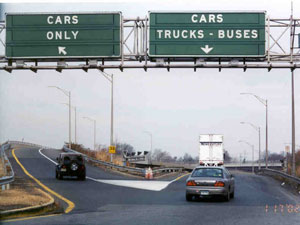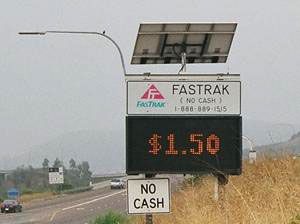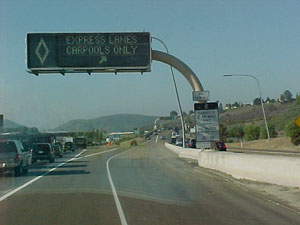|
|
|
Freeway Management Program > Managed Lanes Initiative
 |
MANAGED LANES: A Cross-Cutting StudyNovember 2004 |
 |
 |
NOTICE
This document is disseminated under the sponsorship of the Department of Transportation in the interest of information exchange. The United States Government assumes no liability for its contents or use thereof. This report does not constitute a standard, specification, or regulation.
The United States Government does not endorse products or manufacturers. Trade and manufacturers' names appear in this report only because they are considered essential to the object of the document.
Technical Report Documentation Page
| 1. Report No. FHWA-HOP-05-037 |
2. Government Accession No. | 3. Recipient's Catalog No. | ||
| 4. Title and Subtitle MANAGED LANES: A Cross-Cutting Study |
5. Report Date October 2004 |
|||
| 6. Performing Organization Code HOP |
||||
| 7. Author(s) Collier, Tina and Goodin, Ginger |
8. Performing Organization Report No. Report |
|||
9. Performing Organization Name and Address
|
10. Work Unit No. | |||
| 11. Contract or Grant No. Project No. DTFH61-01-C-00182 |
||||
| 12. Sponsoring Agency Name and Address Operations Office of Transportation Management Federal Highway Administration Room 3404, HOTM, 400 Seventh Street, S.W. Washington, D.C. 20590 |
13. Type of Report and Period Covered |
|||
| 14. Sponsoring Agency Code FHWA |
||||
| 15. Supplementary Notes Research performed in cooperation with the U.S. Department of Transportation, Federal Highway Administration. Research Project Title: FHWA HOV and Managed Lanes Technical Assistance and Support |
||||
| 16. Abstract Increasing traffic congestion in the major metropolitan areas is costing billions of dollars each year in lost productivity, wasted fuel, increasing air pollution and hours of delay. Adding new general-purpose lanes is increasingly difficult because of factors such as construction costs, limited right-of-way, environmental and societal concerns. As a result, agencies are looking for solutions to improve the flow of traffic on existing facilities. One concept being considered is that of "managed lanes". Managed lanes employ various strategies to improve flow and maximize the efficiency of the freeway system. Common types of managed lanes include high-occupancy vehicle (HOV) lanes, high-occupancy toll (HOT) lanes, value priced lanes, or exclusive or special use lanes. For the purposes of this study, managed lanes are defined as a limited number of lanes within an expressway cross section where multiple operating strategies are utilized, and actively adjusted as needed, for the purpose of achieving pre-defined performance objectives. The intent of the report is to review the state-of-the-art in managed lanes in order to increase the understanding of (1) what managed lanes are, (2) how to plan for implementation, (3) what operational and design issues are considered, and (4) how active management of the lanes over the life of the facility affect its implementation. This report describes operating managed lane projects through a case study approach, highlighting best practices of the projects the lessons learned. Emerging issues and knowledge gaps are also presented. The intent of the report is to provide a cross-cutting study of the issues and experiences of various agencies as managed lane projects are implemented and policies are drafted. |
||||
| 17. Key Words Managed lanes, lane management strategies, special use lanes, HOT lanes, HOV lanes |
18. Distribution Statement No restrictions. This document is available to the public through NTIS: National Technical Information Service 5285 Port Royal Road Springfield, Virginia 22161 |
|||
| 19. Security Classif. (of this report) Unclassified |
20. Security Classif. (of this page) Unclassified |
21. No. of Pages 68 |
22. Price | |
Form DOT F 1700.7 (8-72) Reproduction of completed page authorized
MANAGED LANES: A Cross-Cutting Study
Federal Highway Administration
Operations Office of Transportation Management
November 2004
ACKNOWLEDGEMENTS
This study was conducted in cooperation with the staff from the Federal Highway Administration (FHWA) and other agencies. Jon Obenberger, FHWA Infrastructure Office of Program Administration, served as the project director and provided guidance throughout the study. Also providing direction and guidance from FHWA were John Halkias, Patrick DeCorla-Souza, Susan Lee, and Angela Jacobs. Heather Werdick and Kim Kawada from the San Diego Association of Governments provided valuable information. Additionally, Heather Ford with TTI provided assistance with word processing. The assistance of each of these individual is greatly appreciated. Photos used in this report were taken by the Texas Transportation Institute unless otherwise referenced.
TABLE OF CONTENTS
TABLE OF EXHIBITS
Exhibit 1. Lane Management Strategy Complexity
Exhibit 2. Eligibility and Access Control as Lane Management Strategies
Exhibit 3. HOV Lane
Exhibit 4. Dual-Dual Roadway (6)
Exhibit 5. Pricing as a Lane Management Strategy
Exhibit 6. SR 91 Express Lanes Boundaries (7)
Exhibit 7. I-15 Express Lane Boundaries (5)
Exhibit 8. Dynamic Message Board
Exhibit 9. New Jersey Turnpike (6)
Exhibit 10. SR 91 (8)
Exhibit 11. Violation Light
Exhibit 12. Enforcement Camera
Exhibit 13. Pricing Strategies of Case Study Projects
Exhibit 14. Schematic of Separate Truck Lanes on New Jersey Turnpike (9)
Exhibit 15. Signing on New Jersey Turnpike
Exhibit 16. Crash Rates on New Jersey Turnpike (43)
Exhibit 17. Dynamic Message Sign
Exhibit 18. Enforcement Zone
Exhibit 19. New Jersey "Roadway Congested" Sign
Exhibit 20. Life-Cycle of a Facility (10)
Exhibit 21. Parameters for Setting Toll Rates (11)
Exhibit 22. Inland Breeze (12)
Exhibit 23. New Jersey Turnpike Web Site (13)
Exhibit 24. HOV Violation Sign
Exhibit 25. Proposed I-15 Managed Lanes Design (14)
Exhibit 26. Proposed Cross-section for Katy Freeway (15)
Exhibit 27. Costs vs. Revenue for HOV Priority and For-Profit Facilities (17)